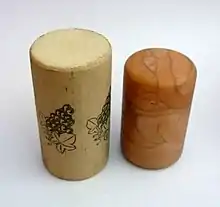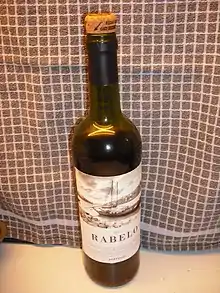Closure (wine bottle)
Closure is a term used in the wine industry to refer to a stopper, the object used to seal a bottle and avoid harmful contact between the wine and oxygen.[1]


They include:[2]
- Traditional natural cork closures ('corks');
- alternative wine closures, such as screw caps, synthetic closures, glass closures.
- Historical applications no longer in use, such as wooden stoppers with cloth or wax
The choice of closure depends on issues such as the risk of cork taint, oxygen permeability and desired life of the wine.[3] Another factor is consumer reaction, with the wine-buying public in Australia and New Zealand positive to alternative closures, while opinion is divided among consumers of the United States.[4] In Europe, perceptions that associate screw caps with low-quality wine may be declining.[3]
Synthetic wine bottle closures may allow for a controlled oxygen transfer rate.[5]
Some natural cork closures may be "easy open, easy recork", removing the need for a corkscrew.
See also
References
- winepros.com.au. The Oxford Companion to Wine. "stoppers". Archived from the original on 2008-08-20. Retrieved 2008-12-14.
- "Beer and Wine Bottling Processes". Meheen. Retrieved 3 August 2014.
- Goode, Jamie, Ph.D. Wines & Vines (August 2008). "Finding Closure". Archived from the original on 2009-04-10.
{{cite web}}: CS1 maint: multiple names: authors list (link) - Asimov, Eric, The New York Times: The Pour (January 25, 2007). "How to Top It Off".
{{cite web}}: CS1 maint: multiple names: authors list (link) - Impact of post-bottling oxygen exposure on the sensory characteristics and phenolic composition of Grenache rosé wines. J. Wirth, S. Caillé, J.M. Souquet, A. Samson, J.B. Dieval, S. Vidal, H. Fulcrand and V. Cheynier, Food Chemistry, 15 June 2012, Volume 132, Issue 4, Pages 1861–1871, 6th International Conference on Water in Food, doi:10.1016/j.foodchem.2011.12.019
External links
- The Oeneo Closures Debate 2006 with Peter Ferriera, John Forrest, Peter Godden, Terry Lee and Jamie Goode